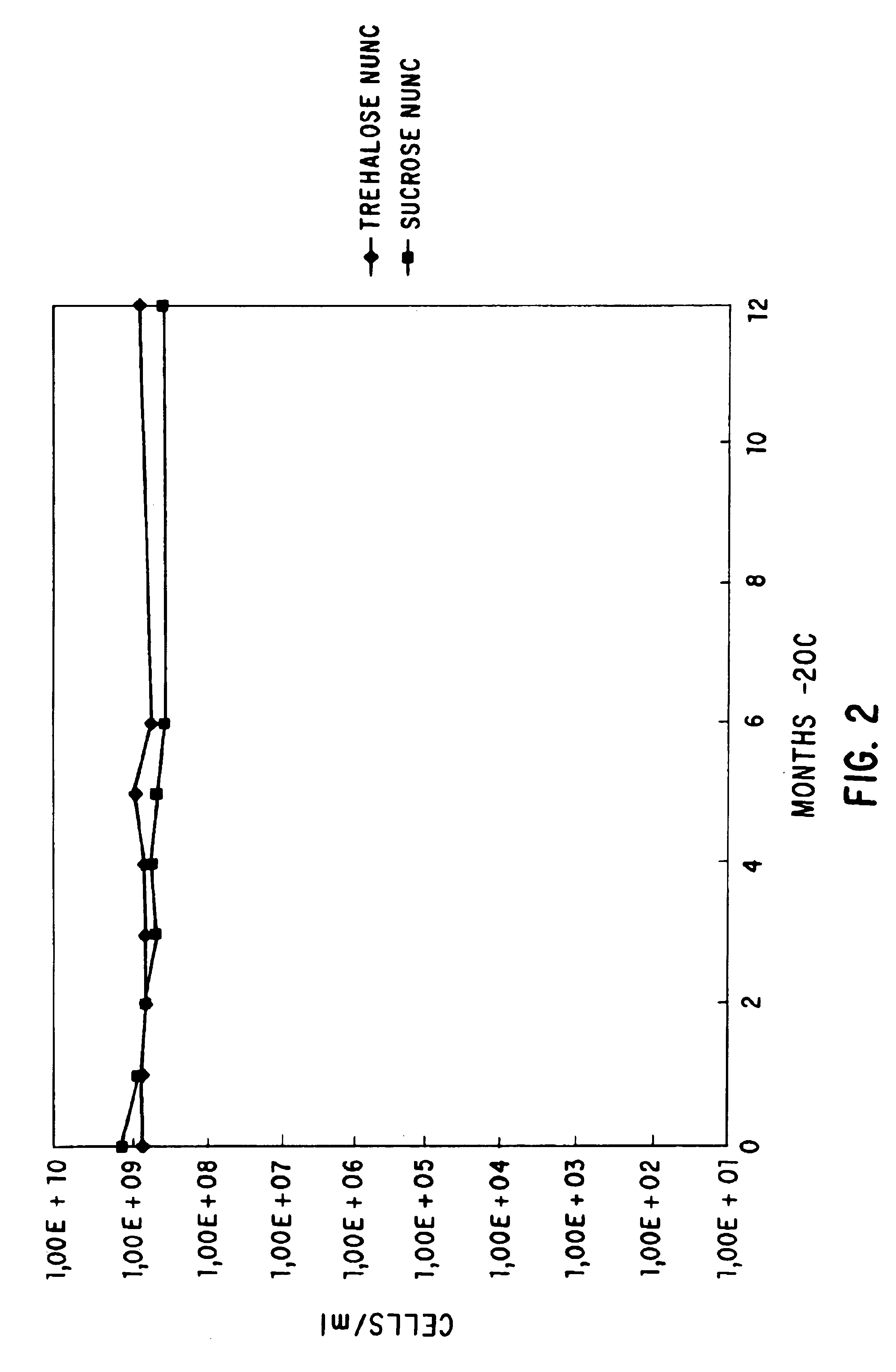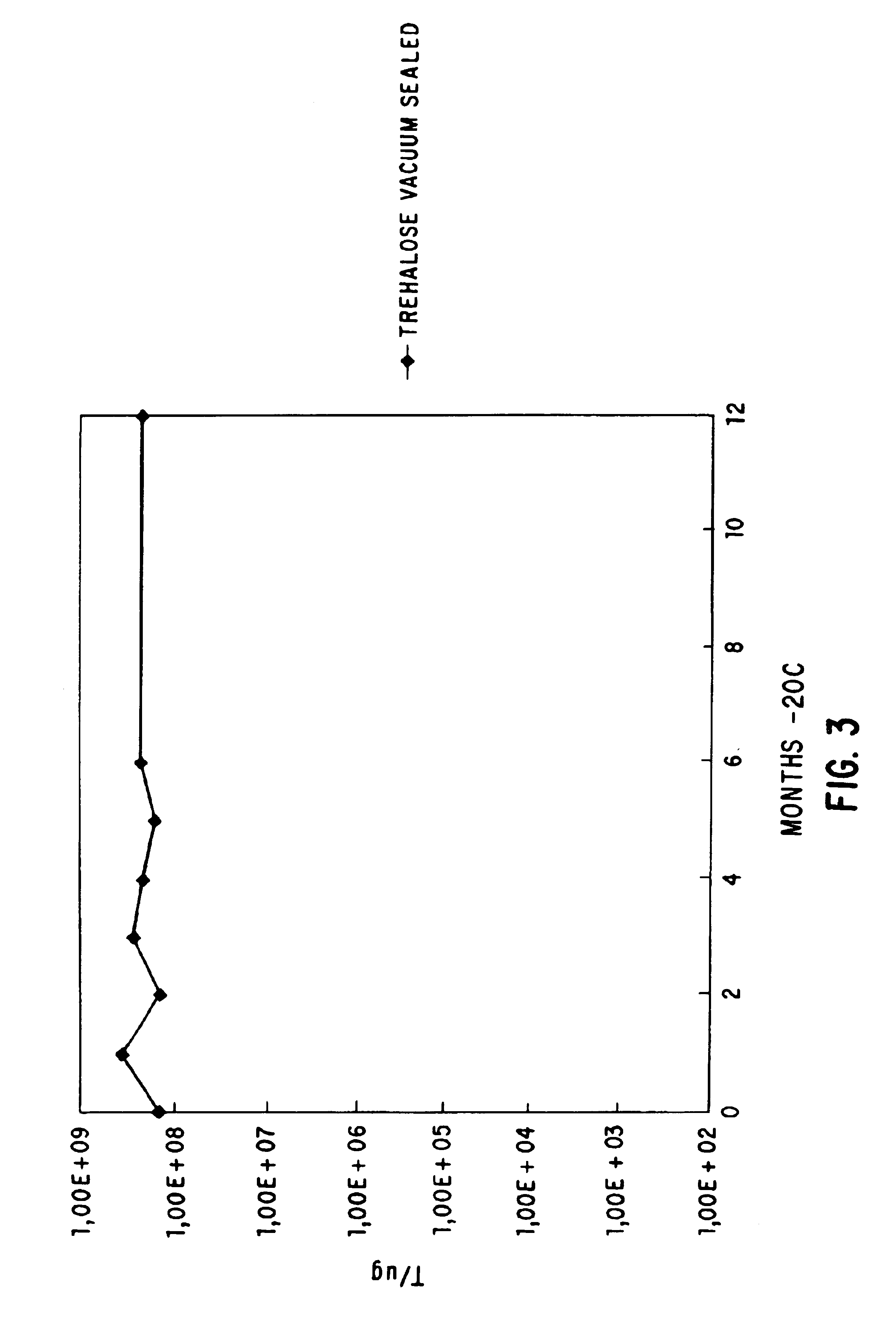Methods for lyophilizing competent cells
a technology of competent cells and lyophilization, applied in the field of producing cells, can solve the problems of extremely unstable cells prepared by the methods outlined above, and achieve the effect of losing the transformation efficiency
- Summary
- Abstract
- Description
- Claims
- Application Information
AI Technical Summary
Benefits of technology
Problems solved by technology
Method used
Image
Examples
example 1
[0059]A seed stock of E. coli DH5α cells (Gibco BRL, Gaithersburg, Md.) was prepared as follows: DH5α cells were streaked on an LB plate (32 g Gibco BRL LB agar (Life Technologies, Inc., Gaithersburg, Md.) per liter distilled water) and the plate was incubated for 36 hours at 23° C. Several colonies were picked into a 500 ml non-baffled shake flask containing 25 ml SOB medium (2% Bacto tryptone, 0.5% Bacto yeast extract 10 mMNaCl, 2.5 mM KCl, 10 mnM MgCl2, 10 mM MgSO4).
[0060]The flask was shaken at 23° C., 275 rpm, for several hours and the optical density at 550 nm is followed. When the optical density had reached 0.5, 10 ml of the cells were mixed with 10 ml of SOB:glycerol 60:40 (60 ml SOB, 40 ml glycerol, (Gibco BRL) in a 50 ml conical tube. The cells were mixed using a vortex mixer and were allowed to remain for 10 min. on ice. 1 ml aliquots were dispensed into NUNC cryovials (Catalog No. 366656) (Life Technologies, Inc., Gaithersburg, Md.) and were frozen in a dry ice ethanol ...
example 2
[0075]The following example was carried out essentially as Example 1 with the following exceptions. The DH5α seed stored at −80° C. was thawed and 600 μl of the seed was inoculated into 1.7 L of SOB medium containing 0.001% PPG in a 2.8 L Fernbach flask. The flask was shaken for 18 hours at 23° C., 275 rpm. When the optical density at 550 nm had reached 0.194, 175 ml of the culture was inoculated into 1.7 L of SOB medium containing 0.001% PPG in a 2.8 L Fernbach flask. The flask was shaken for approximately 4 hours at 23° C., 275 rpm. When the optical density at 550 nm had reached 0.09, 2.7 ml of the culture was inoculated into 2 Fernbach flasks each containing 1.7 L SOB medium and 0.001% PPG. The flasks were shaken at 23° C., 275 rpm, for approximately 22 hours. When the optical density at 550 nm had reached between 0.648 and 0.722, the cultures were harvested and processed as in Example 1, with the exception that the cells were not chilled prior to collection by centrifugation. 20...
example 3
[0077]The following example was carried out essentially as in Example 2 with the following exceptions. Two DH5α seeds were thawed and 800 μl was inoculated into two 2.8 L Fernbach flasks, each containing 1.7 L of SOB medium and 0.001% PPG. The flasks were shaken at 23° C., 275 rpm, for approximately 19 hours. The optical density of the two flasks were 0.3918 and 0.3578, respectively. The cells were collected by centrifugation at 4° C. Each cell pellet was resuspended in 10 ml of room temperature SOB medium containing 0.001% PPG and were pooled (total of 120 ml). A 1:100 dilution of the cells had an optical density of 0.0754, indicating that the cell density was 7.54. Twenty ml of the cells were inoculated into 6 Fernbach flasks, each containing 1.7 L SOB medium and 0.001% PPG. The flasks were shaken at 23° C., 275 rpm, for 6.5 hours, at which time the optical densities of the flasks were 0.705, 0.783, 0.701, 0.749, 0.704, and 0.702. The flasks were chilled on ice for 15 minutes. Ten...
PUM
| Property | Measurement | Unit |
|---|---|---|
| temperature | aaaaa | aaaaa |
| temperatures | aaaaa | aaaaa |
| temperature | aaaaa | aaaaa |
Abstract
Description
Claims
Application Information
 Login to View More
Login to View More - R&D
- Intellectual Property
- Life Sciences
- Materials
- Tech Scout
- Unparalleled Data Quality
- Higher Quality Content
- 60% Fewer Hallucinations
Browse by: Latest US Patents, China's latest patents, Technical Efficacy Thesaurus, Application Domain, Technology Topic, Popular Technical Reports.
© 2025 PatSnap. All rights reserved.Legal|Privacy policy|Modern Slavery Act Transparency Statement|Sitemap|About US| Contact US: help@patsnap.com



